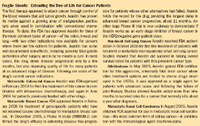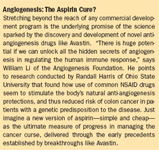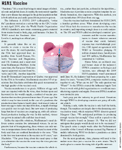Brand of the Year: Avastin
As Genentech's Avastin continues to mature and spread its branches, the company is looking for high profits on the back end.
Pharm Exec's Brand of the Year award recognizes Roche's oncologic, Avastin, not only for the its clinical merits but for the drug's larger symbolic importance in demonstrating the sheer staying power of breakthrough innovation. The steady growth in FDA-approved indications for Avastin is salvation therapy against society's loss of faith in medical progress, expanding the innovation big tent to show that "first in class" can also mean "further to last."
This honor goes to Avastin for its early success in establishing a new clinical paradigm for cancer treatment, bolstered by a baseline of six indications in five tumor types, including the drug's initial approval, in February 2004, for advance-stage colorectal cancer. Two of these—for relapsed glioblastoma and renal/kidney tumors—occurred in the past year. Four other potential indications, covering early stage colon/rectal cancer as well as cancers of the prostate, ovaries and gastric system, await the results of Phase III clinical trials to be presented at medical congresses over the next 12 months.

GETTY IMAGES / GARY S CHAPMAN
All told, Roche has 30 separate discovery and development programs underway to capture Avastin's potential against a variety of metastatic tumors. More importantly, the drug's status as a definitive treatment advance has stimulated complementary strands of useful research, not only in government and academia but within industry itself. According to William Li of the nonprofit Angiogenesis Foundation, 10 cancer drugs modeled on Avastin's unique mechanism of action are now on the US market, and another 120 agents are in clinical trials—26 of which are in Phase III. Roche alone has funded some 450 studies to demonstrate the value of the Avastin franchise to clinicians and patients. Every Big Pharma company with a stake in oncology is focused on research seeking similarly targeted ways to render cancer dormant by undermining initial tumor growth, slowing relapse after surgery or stimulating natural immune responses to replace traditional chemotherapy that attacks healthy as well as malignant cells. Thank Avastin for that.
Avastin is not without controversy, however. Some trials indicate only marginal benefits, particularly when balanced against side-effects that in rare instances can be fatal. But the latent promise of this new line of therapy has stretched the boundaries of what is considered an approvable drug for cancer. Advocacy around the lack of other alternatives for breast cancer patients who fail conventional therapy has persuaded the FDA to allow accelerated approvals on the basis of evidence showing a delay in the worsening of disease, as opposed to the gold standard of increased survival. While some cancer advocates see this as lowering the bar on efficacy, others contend it's a win/win. Patients get another chance to fight, while industry retains an incentive to develop the next innovation. "Even if short-term clinical benefit for a first-in-class like Avastin is modest," Temple University pharmacy Professor Albert Wertheimer told Pharm Exec, "It sustains the momentum of research toward better end points linked to survival and—eventually—a cure."
Pricing: Prove It
Avastin's clinical heft is plated with gold. The drug is the centerpiece of Roche's rich oncology franchise, topping the company product league charts at 5 billion Swiss francs in sales for 2009. Its value as a long term profit spinner for Roche was a factor in management's move last year to convert its 56 percent majority stake in Genentech to full ownership—some analysts forecast Avastin revenues could more than double before the drug's primary US patent expires in 2019.

Fragile Shoots: Extending the Tree of Life for Cancer Patients
To do that, Avastin will not only need to secure additional FDA and EMEA approvals, but also demonstrate better efficacy as an early stage inhibitor of tumor growth—a big if, according to some cancer specialists. "Validating patient benefit to drive the payer investment is at the heart of the debate here," argues Karol Sikora, a practicing oncologist and former professor of cancer medicine at London's Imperial College. "Right now, if you can afford it, Avastin is probably worth the price. But assuming continued growth through additional indications, Roche could halve the price and still double its revenues."
Pricing is the key investment risk facing all oncology drugs today. Avastin's daunting cost and prominence as an early breakthrough in the science of tumor regression means it carries symbolic importance in the debate. The fact that Avastin has been on the market for six years and ranks consistently in the top three drugs in global oncology sales means it could be the first to confront a key question posed by regulators: Is there an expiration date on the label of innovation that confers a premium price? More directly, where is the clinical differentiation against the growing number of competing therapies with a similar mechanism of action?

Philippe Bishop , VP, Clinical Development, Avastin
For Roche, the answer depends on grafting broader applications to backstop Avastin's ability to score against multiple cancers. Company researchers are looking to its potential as an overall early-stage treatment, an inhibitor of post-surgery tumor relapse, a cancer maintenance therapy—even as a preventive. One little-understood aspect of Avastin is that in contrast to many cancer drugs it is well tolerated by patients, over a longer period of time. This might enhance its value as a micro-tumor growth suppressor when used in combination with drugs that target other aspects of cancer biology.
Skeptics Pan a New Path
The rationale for rewarding drug innovation starts with three metrics: time, money, and opportunity. Avastin's storyline is a long one, emerging over three decades from a heretical concept in the biology of vascular cell growth to commercial breakthrough that blocked cancer's spread through the blood supply. The journey began in 1971 with publication in The New England Journal of Medicine of a paper by Harvard professor Judah Folkman positing that cancer cells secrete excess amounts of a molecular substance—Vascular Endothelial Growth Factor (VEGF)—which promotes proliferation of blood vessels that feed tumors and help them metastasize. Folkman dubbed the process angiogenesis, a combination of the Greek words for "vessel" and "birth." His practical conclusion was that if VEGF could be controlled, it could beat back or even render dormant the cancerous growths whose spread depends on their ability to stimulate the formation of new blood vessels.
The cancer community found Folkman's paper fanciful, even threatening. This was especially true for the many researchers trained in the laboratory rather than in the real world setting where Folkman worked as a surgeon, in regular contact with patients suffering from perversely healthy, blood-rich tumors. Plagued by the "not in my back yard" syndrome, Folkman found little institutional support for his conclusions, and it was left to circumstance whether others might take up the challenge of transforming his theory into medical practice.
From Free Time to First in Class
Enter a new company. Genentech was founded in 1976, five years after Folkman published his paper, with a commitment to commercializing the then-emerging field of biotechnology, whose novelty demanded a tolerance for diversity against the conventional wisdom of academic medicine. Genentech built a corporate culture around that necessity, and Avastin was among the first to deliver a payout.
A key element of that culture was the freedom given to Genentech scientists to pursue their own research interests, often on company time. Napoleone Ferrara, an Italian-born physician hired by Genentech in 1988 to help develop a new pregnancy drug, took advantage of that policy to build on previous work he had conducted on cancer formation at the University of California San Francisco. Specifically, he began tests on how developing an antibody to VEGF could shut down blood vessel formation and starve cancerous tumors of the nutrients they needed to grow. His off-hours work led to a successful cloning of the VEGF gene; in 1993, in a peer-review paper published in Nature, he mapped the contours of a monoclonal antibody for VEGF and presented a preclinical model that demonstrated the antibody could suppress angiogenesis and tumor growth.

Angiogenesis: The Aspirin Cure?
Four more years of study and testing followed, and in 1997 Genentech filed an IND for the antibody it called Avastin. Another seven years of human tests went by before the drug secured its first FDA approval in February 2004. In authorizing Avastin, then-FDA Commissioner Mark McLellan praised it as evidence of "the progress of biopharmaceutical innovation. "
Genentech points to the years of study as the embodiment of its distinct mission to focus on new science, with a high tolerance for taking big bets around new pathways for attacking the biological roots of disease. Philippe Bishop, Roche/Genentech's vice president of clinical development for Avastin, told Pharm Exec: "This work shows how individual drive and focused community support can transform a pioneering vision into a useful, life-saving drug. Folkman and Ferrara's insights into the biology of cancer growth would have lain dormant had Genentech not had the organizational courage to take this project on and persevere over the eight years it took to prepare the initial IND and create the molecular basis for an approvable drug."
Managing Risk: Data is Destiny
Genentech took considerable risk early on in amassing the data required to pass FDA muster. The company invested heavily in Phase II trials for Avastin, using randomized protocols to build more knowledge about the drug that could then be applied to help structure the Phase III investigations. At the time, scientists at other companies avoided this approach because poor or inconclusive results in Phase II might serve as a disincentive for management to allow promising projects to go forward. Genentech, a company run by scientists, took the opposite view—whatever the results, big investments in Phase II could help overcome the more significant hurdles likely to be encountered during Phase III, which is the essential test ground for commercialization.
This learn-as-you-go stance also helped Genentech manage the big safety risks in conducting the trials that led to FDA authorization of Avastin against glioblastoma last year. "We knew that Avastin in combination with chemotherapy can cause hemorrhaging in a few patients, and that one intracranial bleed in our human tests for glioblastoma could shut the whole program down," Bishop says. Nevertheless, the company took the risk and leveraged hundreds of studies commissioned for other Avastin tumor types to design appropriate controls for a Phase II study (AVF3708g), the results of which found no new safety signals to limit the drug's use for this virulent form of brain cancer. The company is now conducting a larger Phase III trial to confirm and extend the findings.
Maintaining Market Leadership
Genentech's decades-long commitment to cancer as a therapeutic target ensures that financial and human resources, other knowledge assets and internal organizational structures are all aligned to mitigate the risk in translating innovative science into commercial success. "It's vital in this increasingly crowded cancer field to have both focus and critical mass, and we have it," contends John Orwin, svp in charge of sales and marketing for the company's BioOncology group. Orwin told Pharm Exec that the company has always invested in Avastin for the long term, with a particular emphasis on funding postmarketing approval studies that carry end points meaningful to the patients who use the drug. "Good clinical data based on needs-relevant end points is our best forum for promotion," he says.
Genentech's marketing for Avastin is geared to distinguishing the drug from "the clutter." The company runs a dedicated, technically advanced sales force for Avastin that emphasizes specialized medical education and active interpretation of study results. Commercial teams work closely with the trial investigator community, who serve as thought leaders on cancer and, as prescribers, comprise a key part of the Avastin customer base.
Cracking the Price Nut
Steps have also been taken to serve that portion of the Avastin market without coverage or incomes to defray the product's high cost. The company's Access Solutions program provides subsidized access to Avastin for those who need it, inclusive of clinically eligible patients with household incomes of up to $100,000 per year— a ceiling that covers 85 percent of the US population. Some 350 full-time Genentech employees administer the program. "We don't rely on subcontractors to do this for us, so the service commitment is high," Orwin says. Nevertheless, patient advocates like Sikora contend that Roche at some point has to yield to critics and build more pricing flexibility into the product, particularly as it ages. "Genentech is now a fully integrated part of a global company. Most of Avastin's sales are in the US, and price has not been the driver of access like it has been in the UK and Europe. But that is likely to change," Sikora says.
What Next for Avastin?
With nearly a decade of proprietary life left in Avastin, Genentech believes the franchise is healthy, with much room to grow. But this bet depends on the data: 2010 will see the release of clinical trials to drive additional indications for a range of cancers. Executives also note that the merger with Roche will not change the commitment to Avastin as a truly transformational therapy in the evolving field of anti-angiogenesis. In fact, they contend that Roche's international scale and presence—pre-merger, Roche managed the Avastin portfolio outside the US—can only enhance the capacity to mobilize resources, expertise, and partnering behind some entirely new applications for the product

H1N1 Vaccine
One such area is the development of biomarkers to better predict which patients may gain most from treatment with Avastin. Some 150 potential biomarkers have been studied, but to date none have proven accurate in assessing benefit. In addition, work is underway to increase understanding of the biology behind VEGF so as to anticipate and counter the development of cancer cell resistance to the Avastin antibody. The goal is to use the natural process of angiogenesis to find ways to increase Avastin's staying power in slowing tumor progression. This could establish the drug as a maintenance therapy for patients whose cancer has been removed through surgery or is in remission.
In addition, the company is awaiting the results of the following clinical trials:
» GOG-218, a Phase III study evaluating a combination of Avastin, paclitaxel, and carboplatin chemotherapy to prolong the time without disease for newly diagnosed, untreated women with ovarian cancer. Two other trials on ovarian cancer are also in progress, one of which (ICON7) is testing Avastin as maintenance therapy in increasing progression free survival
» CALGB-90401, a Phase III study to determine if Avastin combined with docetaxel chemotherapy and prednisone can extend survival time for men with prostate cancer whose previous treatment with hormone therapy had failed. The combination with Avastin will be compared against use of the two other drugs alone
» AVANT, a Phase III trial for early-stage colorectal cancer, in which Avastin is being tested with folfox or xelox chemotherapy to determine whether it reduces the recurrence of stage II and III level cancer after surgery
» AVAGAST, a Phase III study to see if Avastin plus xeloda and cisplatin chemotherapy can extend life for patients with previously untreated stomach cancer, compared to chemotherapy alone

Multaq (dronedarone)
Work is also continuing on follow-up trials for breast cancer, glioblastoma and melanoma. A Phase II study (BEAM) released last September found a "statistically insignificant" change in progression free survival for patients with metastatic melanoma, but the company is continuing work because the safety profile was good and there are presently few other treatment options available to patients.
The Misinformation Maze: Navigating Public Health in the Digital Age
March 11th 2025Jennifer Butler, chief commercial officer of Pleio, discusses misinformation's threat to public health, where patients are turning for trustworthy health information, the industry's pivot to peer-to-patient strategies to educate patients, and more.
Navigating Distrust: Pharma in the Age of Social Media
February 18th 2025Ian Baer, Founder and CEO of Sooth, discusses how the growing distrust in social media will impact industry marketing strategies and the relationships between pharmaceutical companies and the patients they aim to serve. He also explains dark social, how to combat misinformation, closing the trust gap, and more.
Applying Porter’s Five Forces to Portfolio Management in Pharmaceutical R&D: A Strategic Roadmap
March 17th 2025The increasing costs and complexity of R&D in the pharmaceutical industry have necessitated the adoption of strategic portfolio management to optimize resource allocation and enhance competitive advantage.
